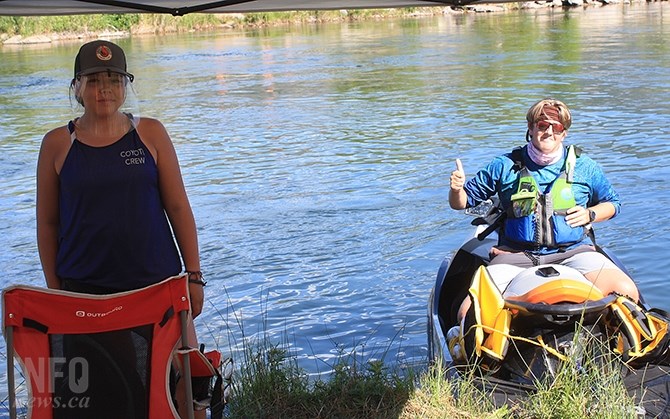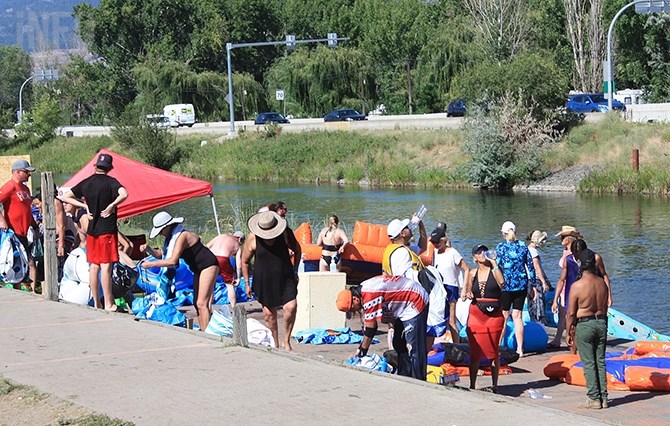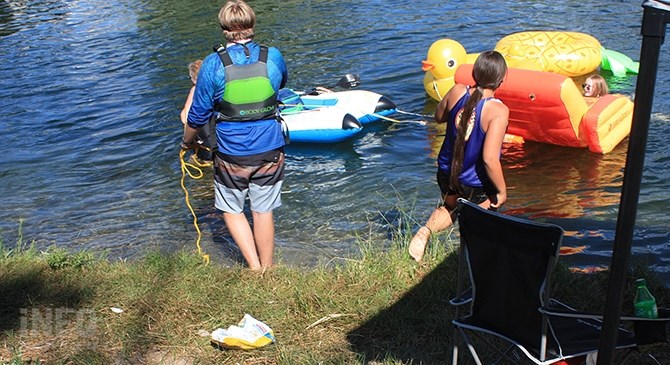
Coyote Cruises employee Jenessa Kruger and Max Burko work an aid station beyond the channel exit, snagging tubers who drift under the Highway 97 bridge.
(STEVE ARSTAD / iNFOnews.ca)
July 25, 2020 - 7:00 AM
The Penticton Fire Department has been making most of the headlines in the past couple of weeks as a fast flowing Okanagan River channel has resulted in several callouts by the department to help channel floaters in distress.
However, there are a couple of unsung heroes at the end of the channel that have likely assisted more channel floaters than the fire department over the past two weeks.
Max Burko and Jenessa Kruger spend their days under a canopy just south of the bridge on Highway 97, ready to lend a hand to channel floaters who fail to stop at the exit steps just north of the bridge.
Burko says he’s there “on his own terms, helping out,” while Kruger is an employee of Coyote Cruises.
“We’ve lent a hand to up to 25 parties on a busy day, but we probably average six parties a day,” Burko, who doesn’t like to call them rescues, says.

Coyote Cruises spokesperson Mike Campol says social distancing is becoming an issue at the channel exit, urging channel floaters to practice COVID-19 protocols.
(STEVE ARSTAD / iNFOnews.ca)
Burko supplies his own jet ski to the cause. As floaters drift by, the two ask if help is needed and if so, a line is tossed out. Sometimes Burko uses his jet ski to give them a tow back under the bridge to the exit area.
Nation First Consulting Group’s Mike Campol, on behalf of Coyote Cruises, calls the pair’s efforts “pretty cool.”
“I’ve been down there a couple of times. People were cheering as the gave people some help. It was a pretty cool spectacle,” he says.
The two are there to assist anyone having difficulty, not just Coyote Cruise customers.
Campol says things are improving on a daily basis on the channel after implementation of some new safety procedures.
The company shut down for several days earlier this month to identify and deal with safety issues created by high, fast flowing channel water this year, adding warning signs along the channel bank near the exit, and stationing Kruger and Burko at the channel mouth.
“The signage is preparing most people to move to the right and prepare to exit the channel, but some people are panicking when they see the signage, expecting something terrible will happen if they get to the bridge, when they could probably still paddle to shore,” he says.

Max Burko and Jenessa Kruger assist a group of channel floaters who accidently went beyond the exit point on Thursday, July 23.
(STEVE ARSTAD / iNFOnews.ca)
Compol says the most important thing channel floaters need to know is to not tie their tubes together.
“That’s where the real danger lays. We make sure our customers can’t,” he says.
One of the most recent concerns the tubing operator is facing in recent days is a breakdown in social distancing, especially at the channel exit.
“It’s an important message for everyone. There’s lots of space there, and we need everyone to take more responsibility,” he says.
The cruise operator sanitizes its buses and tubes after each trip. Campol says the company is doing its best to ensure social distancing is being practised at entry and exit points, but can’t control those who are not customers.
Penticton Fire Department chief Larry Watkinson says the department is averaging a call a day to the channel this week.
“Call volume to the channel is way up over last year. The big messaging for us is to maintain your situational awareness, understanding your surroundings and not getting tangled up, and avoiding those bridge abutments are critical pieces,” he says.
The department was called to the channel twice Monday, July 24. Fortunately, no injuries were reported in either incident.
Okanagan Lake dam operator Shaun Reimer says outflow through the dam was reduced by 15 per cent earlier this week to ease the current and to help control the rising water levels of Vaseux Lake downstream.
He says the current flow is still much higher than normal for this time of year.
Okanagan Lake is now within a few centimetres of full pool, but the higher channel flows will likely be in place for several more weeks.
Reimer says channel floaters will find the current strongest from the channel entry point to Green Mountain Road, which is roughly the halfway point.
“South of there, to the exit near Skaha Lake, the channel is deeper, which tends to lessen the current, although it would likely be much more noticeable during regular flow rates,” he said in an email.
Channel floaters are experiencing a total float time of an hour and fifteen minutes to cruise the roughly six-kilometre channel distance, which Reimer says is “about right.”
He says during low flow years the trip can take as long as four hours.
To contact a reporter for this story, email Steve Arstad or call 250-488-3065 or email the editor. You can also submit photos, videos or news tips to tips@infonews.ca and be entered to win a monthly prize draw.
We welcome your comments and opinions on our stories but play nice. We won't censor or delete comments unless they contain off-topic statements or links, unnecessary vulgarity, false facts, spam or obviously fake profiles. If you have any concerns about what you see in comments, email the editor in the link above.
News from © iNFOnews, 2020